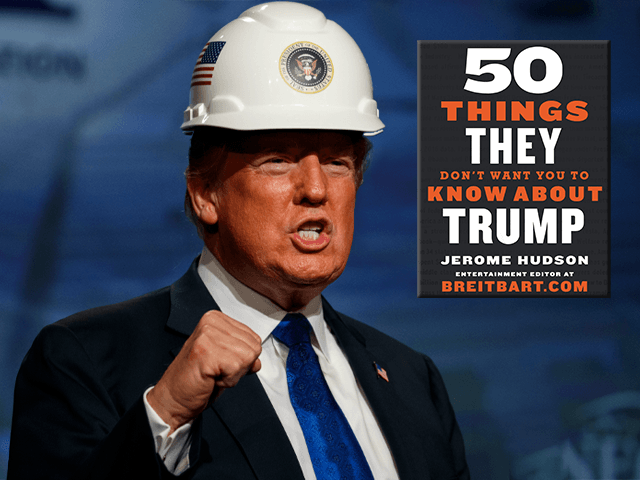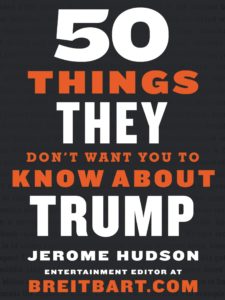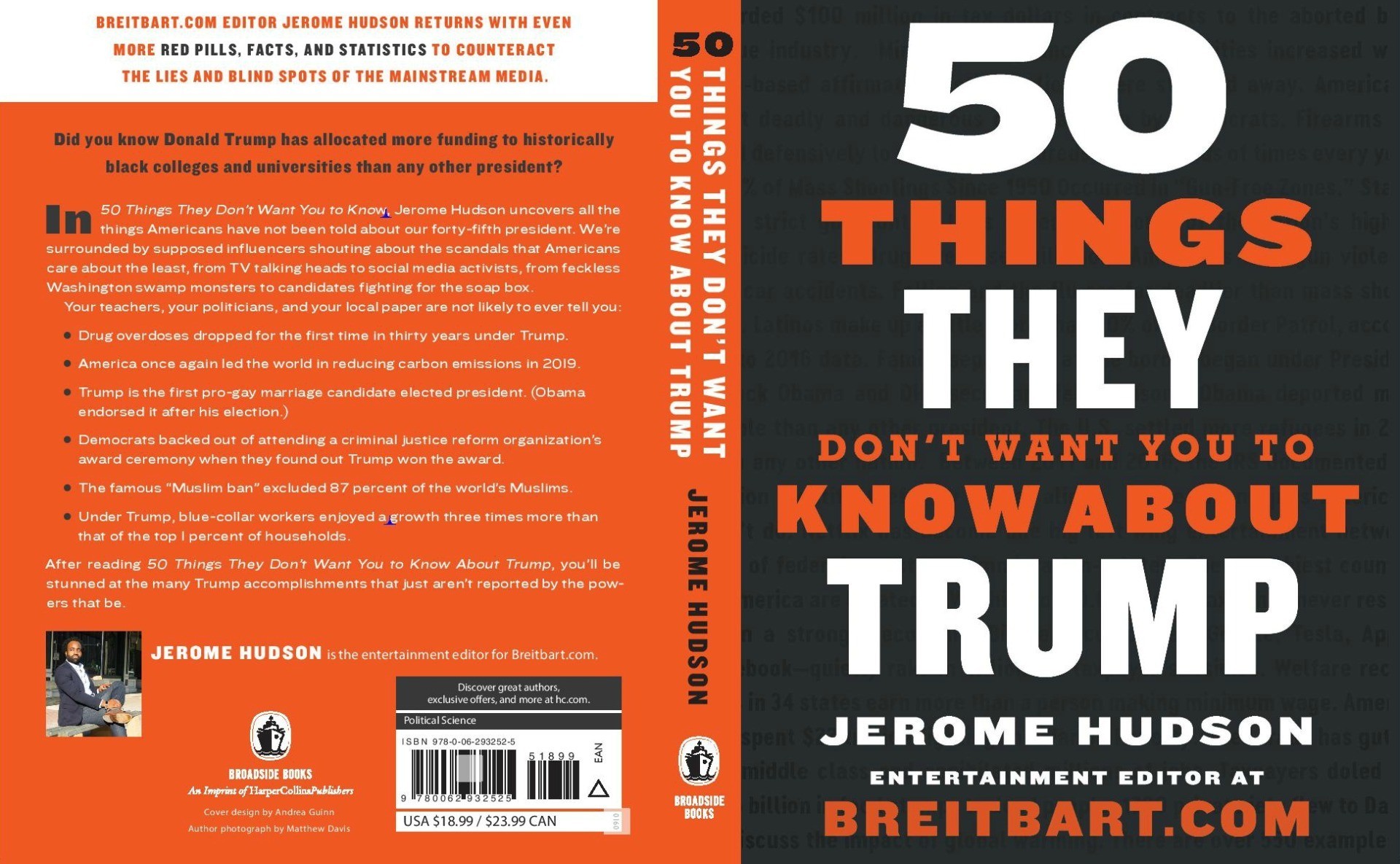The following is an excerpt from 50 Things They Don’t Want You to Know About Trump, the new book by Breitbart News Entertainment Editor Jerome Hudson.
50 Things They Don’t Want You to Know About Trump is due out October 27 and available for purchase here. The excerpt is from pages 254-258.
President Donald Trump constantly committed to reviving American industry during his 2016 presidential campaign, promising that he’d bring back jobs that the country lost due to unfair trade deals. His loud appeals to blue-collar laborers went a long way toward putting him in the White House, even though they garnered ceaseless skepticism from the establishment media, mainstream economists, and his predecessor.
New York Times columnist Paul Krugman said weeks after Trump’s election that the president would never bring back lost manufacturing jobs. Krugman declared that “nothing policy can do will bring back those lost jobs. The service sector is the future of work; but nobody wants to hear it.” At a PBS town hall in June 2016, former President Barack Obama poured cold water on Trump’s promise to restore a manufacturing jobs sector that’d been slowly picked apart for decades. Obama contended that decades of America’s diminished dominance in manufacturing was proof of a larger global trend. “Well, how exactly are you going to do that?” Obama asked rhetorically. “What exactly are you going to do? There’s no answer to it. He just says, ‘Well, I’m going to negotiate a better deal.’ Well, what, how exactly are you going to negotiate that? What magic wand do you have? And usually the answer is, he doesn’t have an answer.” It was Barack Obama who oversaw a stagnant and declining manufacturing sector during his eight years in office. According to the U.S. Bureau of Labor Statistics (BLS), Obama’s economy produced less than 100,000 manufacturing jobs across the nation during his last two years in office. In contrast to Obama, manufacturing jobs started soaring shortly after Trump assumed office in January 2017.
Since the Trump Administration’s red-tape–cutting policies and the tax cut and reform law passed in December 2017, manufacturers added 467,000 jobs, more than six times the 73,000 manufacturing jobs added in Obama’s last two years.
Looking at Trump’s first two years, the revised BLS data shows that more than two manufacturing jobs were added for every one job added in government at the federal, state, and local level. In contrast, under Obama, almost five government jobs were added for every one manufacturing job.
Since President Trump took office in January 2017, employment in manufacturing has increased 3.7 percent. Over the same period during the last two years under President Obama, manufacturing payrolls grew by only 0.6 percent.
Justin Haskins, the editorial director and a research fellow at the Heartland Institute, noted in an op-ed in The Hill in January 2020 that Democratic lawmakers fundamentally misunderstand job creation. Instead, Haskins argues that what’s necessary for the economy to flourish is to allow business owners to operate with minimal government interference.
“What Obama and others in the Democratic Party didn’t understand—and judging by the rhetoric coming from the current batch of presidential candidates, still don’t understand—is that you don’t need a magic wand to grow the economy,” Haskins wrote. “All that is required are policies that give individuals and businesses more power to operate freely and that limit efforts by inept, greedy government bureaucrats in Washington to meddle and manipulate markets they don’t fully understand.”
Haskins noted that the Trump administration had signed 16 bills to slash regulation and eliminated 8 and a half rules for every new statute instituted. “Since January 2017, more than 480,000 manufacturing jobs have been added to the U.S. economy, following two decades of sharp losses,” Haskins wrote. The Heartland Institute editorial director explained that during President Clinton’s final three years in office, the country lost more than 430,000 manufacturing jobs, and during George W. Bush’s time in office, Americans lost millions of manufacturing jobs, even before the 2008 financial crisis. “Roughly 300,000 manufacturing jobs were lost during the eight years of the Obama administration, including minor losses in Obama’s final year in office.” Haskins emphasized, “In terms of the percentage of manufacturing job increases, the gains made thus far under the Trump administration surpass the performance in the first term of every president since the 1970s.”
So much of Trump’s manufacturing renaissance has occurred in the Rust Belt of Iowa, Minnesota, and Wisconsin—a critical swath of states that proved crucial to the working-class coalition President Trump relied on in November 2016. Pennsylvania has also experienced much of the manufacturing boom under Trump. Under Obama, the Keystone State, a big blue-collar bastion, lost more than 45,000 manufacturing jobs. During the early years of Trump’s presidency, Pennsylvania gained roughly 23,000 manufacturing jobs.
Trump’s appeal to blue-collar workers led to his 2016 win in Pennsylvania, which a Republican president had not won since George H.W. Bush’s 1988 presidential election nearly three decades earlier. Haskins described the manufacturing boom as “Trump’s big reelection weapon.”
“It turns out that you don’t need incantations or even a ‘magic wand’ to improve manufacturing job growth. You do, however, need public policies in place that promote U.S. businesses, instead of punishing them with ever-higher taxes, regulations, and mandates,” Haskins noted. “President Trump understands this reality, and he’s poised to reap the benefits in 2020 as a result.”
Trump and other Republicans have mocked Obama because Trump revived the economy that Obama could not, and went so far as to say could not be revived. Donald Trump, Jr., the president’s son, said in September 2018, “Okay, remember when Obama said you need a magic wand to make that happen? Well, abracadabra, Obama. We’re doing it.”
“I guess I have a magic wand, 4.2 percent [GDP], and we will do MUCH better than this! We have just begun.” President Trump fired back in September 2018.



COMMENTS
Please let us know if you're having issues with commenting.